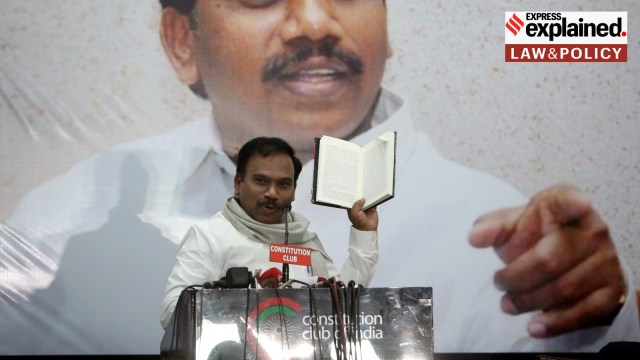© The Indian Express Pvt Ltd
Latest Comment
Post Comment
Read Comments
 A Raja during the release of his book about the 2G scam in New Delhi, 2018. (Express Photo by Praveen Khanna)
A Raja during the release of his book about the 2G scam in New Delhi, 2018. (Express Photo by Praveen Khanna)Attorney General R Venkataramani, on April 22, mentioned an application filed by the Centre to modify the Supreme Court’s 2012 judgement in the 2G spectrum scam case. The Centre’s application asks the Court to clarify if it can assign 2G spectrum licenses through an administrative process, as opposed to assignment through an auction — as prescribed by the SC in 2012.
What is the 2G scam case? Why is the Centre seeking a modification of the apex court’s decision?
In 2008, under then Telecom Minister A Raja, the Department of Telecommunications (DoT) issued 2G spectrum licenses to specific telecom operators on a first-cum-first-serve basis. The cut-off date for applications was brought forward from October 1 to September 25, and 122 licenses were granted to private telecom operators.
In 2009 ,the Central Vigilance Commission directed the CBI to investigate claims that there were illegalities in the allocation of licenses, following which the CBI filed a first information report against unknown officers of the DoT, private persons and companies. In the meantime, the Centre for Public Interest Litigation and Subramanian Swamy filed petitions at the Supreme Court alleging a Rs 70,000 crore scam in the grant of telecom licenses in 2008.
In 2010, the Comptroller and Auditor General of India (CAG) filed a report claiming that the allocation had caused a loss of Rs 1.76 lakh crores to the public exchequer. Raja resigned shortly after. In 2011 the CBI filed its first chargesheet, in which Raja was an accused.
In February 2012, the Supreme Court cancelled the 122 licenses granted during Raja’s tenure. The court found that Raja had allocated licenses in 2008 based on 2001 prices in order to benefit specific private telecom operators. It also found that using methods like first-come-first-serve when allocation of public property is “likely to be misused by unscrupulous people who are only interested in garnering maximum financial benefit”. Instead, the court held that “the State is duty bound to adopt the method of auction by giving wide publicity so that all eligible persons can participate in the process”.
The Centre has stated that since the 2G scam judgement, the allocation of spectrum has taken place through regular auctions. However, it has raised the point that allocation of spectrum is not limited to commercial telecommunication services and is also necessary for “public interest functions such as security, safety, disaster preparedness, etc.”
Further, the Centre has argued that there are certain situations where auctions are not “technically or economically preferred or optimal” such as situations where there is a one-time or sporadic use.
The application also refers to the Apex Court’s clarification in September 2012 that the auction method that was prescribed in 2012 was not a “constitutional principle” and is not to be considered as an “absolute or blanket statement applicable across all natural resources”. The court clarified that it “respects the mandate and the wisdom of the executive for such matters”.
Referring to this decision, the Centre has asked for clarity on whether it can allocate 2G spectrum in the future through an administrative process “if so determined through due process in accordance with the law” in situations where an auction is not preferable in the interest of the public or for technical and economic reasons.